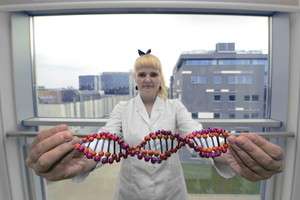Spatial distribution of genetic material affects neuropsychiatric health

Changes in spatial distribution of genetic material can lead to neuropsychiatric disorders, as discovered by Spanish-Polish team of researchers. The investigationof the genetically modified laboratory mice define new directions in the fight against neuropsychiatric disorders in humans; they also suggest that the results of some previous studies of mouse behavior might be misinterpreted.
Some mental disorders are genetic. Researchers from the Nencki Institute of Experimental Biology in Warsaw and the Spanish Instituto de Neurociencias de Alicante (INA) have shown, however, that the relationship between the psyche and genes may be more subtle than previously thought. In genetically modified laboratory mice, they found changes in the spatial distribution of genetic material fibers in neurons – and the accompanying disturbances in behavior. The results of the team headed by prof. Angel Barco (INA) have been published in the famous magazine Nature Communications.
"DNA in the cells is not naked – it is wrapped around proteins called histones to form chromatin fibers", begins to explain Dr. Adriana Magalska of Nencki Institute and immediately adds: "Most people certainly are familiar with a picture of human chromosomes that resemble the letter X. This is properly coiled chromatin that is responsible for the characteristic packing of the genetic material".
To be able to observe the chromatin, the researchers marked it with green fluorescent protein (GFP). GFP is a non-toxic protein, which when illuminated by laser light emits green fluorescence. In molecular biology it is used to mark specific types of cells and to study gene activity. It has so many uses that for its discovery, the Nobel Prize was awarded.
In the mice studied by the Polish-Spanish team, the gene producing GFP works only in neurons and remains inactive when the mice are given one of the antibiotics, doxycycline. So, if the mouse receives the antibiotic from birth, the gene remains inactive and the animal develops normally. At a time convenient for researchers, doxycycline can be discontinued, to activate the production of GFP in neurons. Then one can see what changes have occurred in these cells as a result of the conducted experiments. Most importantly, through the use of genetic engineering, in these genetically modified mice GFP is coupled to one of the histones of chromatin. This means that in practice all the chromatin of transgenic mice is labeled with GFP protein.
"Normal nuclei of mouse neurons contain regions of highly condensed chromatin called chromocenters that can be observed under a microscope as bright, spherical objects after cells are labeled with DNA stain. They contain genes that are inactive", says Grzegorz Wilczynski, Assoc. Professor at Nencki Institute.
A custom-made proprietary software for image analysis, created by Dr. Blazej Ruszczycki from the Nencki Institute, has allowed researchers to transform a sequence of microscopic images to three-dimensional visualization. This visualization allowed Polish scientists to find marked differences in the spatial structure of the chromatin in transgenic mice producing activated GFP gene fused with a histone. The three-dimensional structure of the chromatin in the nucleus of the neurons of transgenic mice was found to be different than in wild type mice: chromocenters were bigger, not tightly focused, but more "fuzzy". It was also found that the modified spatial configuration of chromatin affects the production of certain proteins, which in turn leads to different than normal behavior of the mice.
"Transgenic mice were found to have significantly lower levels of serotonin and dopamine receptors. Both proteins are involved, inter alia, in emotional processes, including depressive disorders", says Dr. Magalska.
The Spanish part of the team carried out accurate tests of animal behavior. The results were unequivocal. Compared with the wild-type, the modified mice were hyperactive, showed signs of autism, had trouble with remembering and making new interactions with other individuals.
The results of the Spanish-Polish team mean that the activation of the gene that produces GFP combined with histone leads in mouse neurons to epigenetic changes, i.e. changes in which the activation and deactivation of the genes is determined not by DNA sequence, but by its immediate surroundings. These changes affect neuronal function, which results in the appearance of behavioral disorders in mice.
"If the changes in the spatial orientation of the DNA fibers result in neuropsychological impairment in mice, it seems likely that they may also lead to them in humans. This may be important, for example, to autism. The finding points to future areas of research, with potentially important implications for the development of modern medicine", says Prof. Wilczynski.
But the Polish-Spanish publication is also important for another reason. For years in laboratories around the world genetically modified mice are used in experiments on behavior. Until now, all scientists were convinced that the introduction of GFP does not affect the reactions of animals. It is already known that it is not. Some previously published scientific studies might therefore be based on improperly interpreted data.
More information: "Loss of neuronal 3D chromatin organization causes transcriptional and behavioural deficits related to serotonergic dysfunction"; S. Ito, A. Magalska, M. Alcaraz-Iborra, J. P. Lopez-Atalaya, V. Rovira, B. Contreras-Moreira, M. Lipinski, R. Olivares, J. Martinez-Hernandez, B. Ruszczycki, R. Lujan, E. Geijo-Barrientos, G. M. Wilczynski, A. Barco; Nature Communications, 5:4450 (2014); DOI: 10.1038/ncomms5450
















